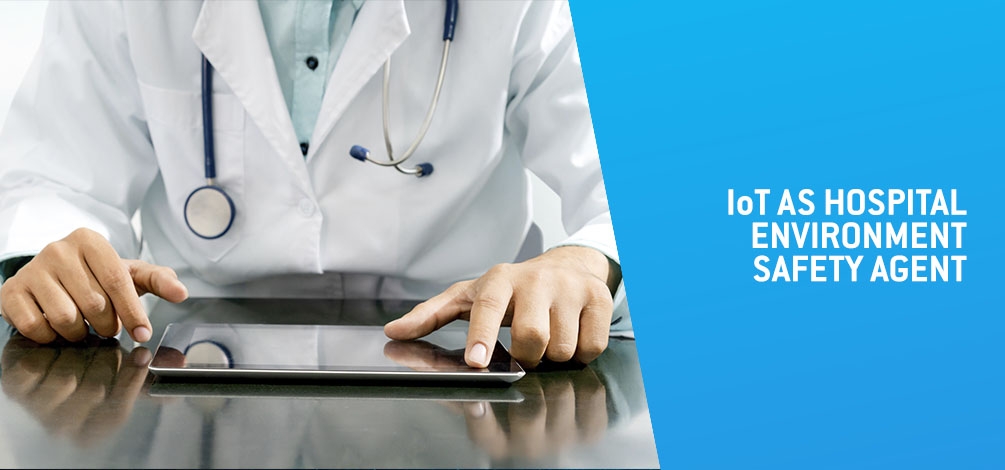IoT AS HOSPITAL ENVIRONMENT SAFETY AGENT

The technological concept of IoT aroused an evolution in the improvement of health care offered based on the continuous analysis of hospital environments.
According to the report from the market analysis entity Grand View Research, the global health sector is aiming to an investment around $410 billion in IoT devices, services and software by 2022, compared to the $58.9 billion invested in 2014. This abrupt budget gap over a short period of time reveals the value of new technologies in this sector and how it can benefit from their implementation.
Versatility is a hallmark of the Internet of Things (IoT). In data-driven environments, deployment possibilities continually unfold. The differentiating factor is the way the information generated by this network is used to its advantage. The technological concept of IoT aroused an evolution in the improvement of health care offered based on the continuous analysis of hospital environments. Continuous and simplified access to information favors timely decision-making in solving problems that result in accurate resource management and increased quality of services.
The successive commitment and triumph from the complex and multifaceted context of the IoT in the hospital framework goes hand in hand with the visibility that the data keeps resulting from the monitoring of the different areas that a hospital complex encompasses. We can hardly manage efficiently or guarantee anything we don’t know about because we don’t measure or control it.
The safety of hospital components applied in treatments is a concrete example of the impact that monitoring can have on product quality. The hospital cold network is a support system for the care provided on the facilities and is regulated by standards and guidelines that reinforce its operational conditions. It is an example, operating in Portugal, of a guidance stipulated by the Direção Geral de Saúde for the cold network of the places where vaccines are administered. Assets protected by this system, such as vacines, reagentes, tissues, preserved cryo cells, represent economic values of millions of euros and where equipment failure can have a major impact on the institution’s financial management and human life. The prescription of compromised elements is no longer a compromising risk with the implementation of a real time monitoring system.
The air flow in a scenario that is susceptible to the presence of contagious elements implies that the maintenance of the conditions of indoor environment is due to extraordinary safety measures in order to minimize the risk of nosocomial infections that may have repercussions on the patient’s health.
Bringing possibilities into practical applications offers a more practical view of the diverse implementation of IoT solutions – operating rooms and laboratory temperature and humidity monitoring; recording of temperature, humidity and CO2 values in more affluent places such as waiting rooms, emergencies; water quality parameterization based on the ph level analysis; controlled pressure chamber/space monitoring.
The information returned by the IoT solutions describes in real time the state of operation of the facilities and equipment and assists in gathering information that benefits the decision-making process for the different cases that may appear.
HOSPITAL ECOSYSTEM DATA
In functional perspective analysis mode for IoT solutions, data is collected from several sensors installed and enciphered through the network structure, consisting of repeaters and gateways to a cloud platform. The full availability of information from this point onwards allows registered users on the platform to have multi-device access that gives unlimited mobility to the information circuit.
The requirements demanded for an IoT platform, in order to be able to respond assertively to the challenge of the user experience and technical application framework, must be user-friendly, safe, modular and configurable. However, there are some highlights that show its effectiveness in the success of hospital management.
As key points of an evolved IoT platform, there are features that enhance your application:
- Configurable alarm
The possibility of setting up a custom alarm system, which when recording values other than those set as safe for operation, can issue warnings to the user, either on the platform or to a mobile device. In the operational context of the solution, the spontaneous financial return promoted by this feature reveals the importance of event detection automation as well as its resolution;
- Co-operation with existing systems
Keeping the IoT platform accessible to third-party systems through standard protocols already defined for the market leaves open the possibility of upgrading systems already installed in organizations;
FINAL CONCLUSIONS
The outstanding efficiency of IoT solutions in the decision-making process regarding hospital environment management is part of a proven reality. The integration of data collected in monitoring, maintenance procedures and facility management leads to increased operational effectiveness of organizations. Technology emerges in this area as another element at the service of improving health care provided in hospital environments.